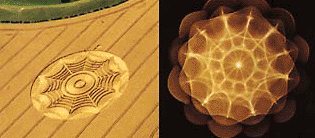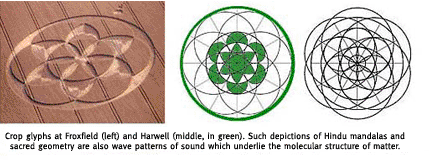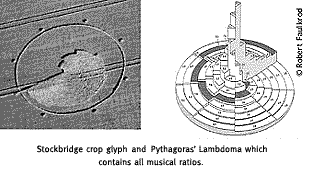|
|
|
|
|
|
| cr |
|
 |
|
|
 |
|
|
|
|
Extracts from Secrets in the Fields © Freddy Silva, 1997, 2002, 2010.
Images © Freddy Silva, Lucy Pringle, Colin Andrews. Cymatics images from Cymatics: A Study of Wave Phenomena and Vibration by Hans Jenny. © 2001 Macromedia, and courtesy of Jeff Volk.
During the twilight days of 1998, small articles tucked away in the nether regions of the British press quietly announced that “Unknown Force Was Behind Corn Circles, Claims Hoaxer.” This dramatic U-turn by the surviving member of the infamous Doug and Dave—the English sexagenarians who, since 1991, have misled the world with tales of their crop-flattening prowess with planks of wood—illustrates that the hand of man materialized in crop-circle lore long after the real phenomenon manifested.
Although hoaxers claim to have orchestrated the phenomenon in 1978, unpublished evidence at the time showed approximately 200 reports of crop circles being created around the world throughout the 20th century, with dozens of eyewitnesses reporting crop circles forming in a matter of seconds as far back as 1890. Several highly descriptive accounts were even documented in 1678 by Robert Plot, the then-curator of the Ashmolean Library in Oxford, England.
To date, some 10,000 crop circles have been catalogued in 29 countries worldwide, and their anomalous features continue to defy human replication. They include plants bent an inch above soil; stems lightly burned around the base; the evaporation of ground-water; the crystalline structure of the plants and the soil altered by the rapid application of electromagnetic or sonic frequencies with the pressure of several atmospheres; dowsable, long-lasting energy patterns in and around the designs, not to mention hundreds of effects on the human biological field – such as increased right brain activity, multiple menstruation cycles in women, healing of retinal tumors – many of them scientifically monitored.
So much, then, for two guys and a piece of wood. But thanks to a virtual embargo on media coverage on crop circle research – for the most part due to well-planned debunking by the British military and skeptical articles introduced into the media by fictitious press agencies – a myth has developed that all crop circles have been nothing more than a “prank with a plank.”
By definition, a hoax is a forgery, and a forger requires an original from which to copy. So what is this 'unknown force' that creates genuine crop circles? One answer may lie with sound.
|
|
|
 |
|
|
|
SOUND , THE FOUNDATION OF LIFE.
Traditionally, sound is considered to be a prime universal force in the creation of matter. This concept is echoed in all faiths and traditions: “In the beginning was the Word, and the Word was with God,” says not only the Christian Bible, but also the Islamic Q’ran and the Hindu Rig Veda. In a similar way, Hopi and Navajo religious traditions assert that, in ancient times, shamans could utter words onto sand and create orderly geometric patterns. This idea of sound expressing itself in geometric form is seen in the Hindu mandalas, those geometric sand and textile paintings that the Hindu believe are expressions of vibrations from the unseen universe. And because the heavenly realms were believed to be the domain of the Gods, the ancients chose to call these orderly expressions sacred geometry.
Consequently, the Eastern faiths—Islam in particular—chose this sacred geometry to express the image of God in their life – in art, mosques, even the very furniture they lived with. In the 12th century, these geometric principles were encoded in the design of Gothic cathedrals, and their application is now understood to be a kind of spiritual technology which enhances the buildings’ sonic effects, for the singular purpose of creating sympathetic vibrations on the human body. Since the body is itself a series of geometric forms (as exemplified by Leonardo Da Vinci’s famous drawing of the outstretched man), its interaction with other forms of geometry allows for the enhancement of higher levels of awareness while the devotee prays within the cathedral’s sacred space.
Geometry, sound, resonance, and vibration are fundamental to our supposedly physical world. For instance, when the primeval Hindu sound—the OM (from which is derived our modern term “hum”)—is sung into a tonoscope (a device for converting the human voice into visible form) it creates geometric shapes such as pentagrams, hexagrams, even complex mandalas.
Such well-known geometric shapes are also found in the microscopic world of atoms. Thanks to advancements in technology we can now see how atoms are not as solid as once believed, but tiny harmonic resonators whose molecules dance in geometric rhythms around a central node. And these rhythms often trace out the shape of the pentagram and the hexagram. What is interesting is that the geometric relationships and proportions found in the molecular world are related to the vibratory intervals governing the notes of the pure music scale. For example, the gap in the frequency between the notes C (261 vibrations per second) and G (312 vibrations per second) can also be represented geometrically as a pentagram.
Physical reality, it now appears, is governed by geometric arrays that are directly related to sound frequencies.
|
|
|
|
 |
|
|
|
|
CROP CIRCLES YIELD NEW GEOMETRIC THEOREMS
One of the mathematical minds studying crop circles was the late Prof. Gerald Hawkins. In February of 1992, he published an interesting challenge in Science News. Professor Hawkins had studied the work of Euclid, a Greek mathematician of the third-century BC whose treatises still form the basis of our knowledge of mathematics today. He used the principles of Euclid to prove that four geometric theorems can be derived from the relationships of crop circle designs. More significantly, he eluded to a previously unknown fifth theorem from which he could derive the other four, a theorem that Euclid himself had not even discovered.
Hawkins challenged Science News’ 250,000 readers to come up with this fifth theorem, but no one was able to create it. Needless to say. it came as a shock when the theorem later materialized as a 160,000 sq. ft. crop circle at Litchfield, England, in 1995. Incredibly, the theorem did not appear overtly, but had to be decoded from within the design.
By 1995, crop circles bearing other unmistakable associations with sound began to appear. One contained a curious design feature resembling a ratchet. Connecting all the points of the design reveals a diagram – the Lambdoma– which dates to the ancient Egyptian Mysteries schools. This musical diagram, also known as the Pythagorean Table, defines the exact relationships between the harmonics of musical notes and the mathematical ratios that govern them. This is accomplished by translating sound frequencies in hertz relative to each musical interval into feet, which generates this circular mandala. But it was a convincing crop circle etched in barley at Goodwood Clatford, England, in 1996 that gave the proverbial nod to sound by reproducing a cymatic pattern.
|
|
|
 |
|
|
|
PATTERNS FROM SOUND
Cymatics is the study of sound waves and their interaction with physical substances. One of its modern pupils was Swiss scientist Hans Jenny who, throughout the 1950s and ‘60s, captured on film the effects of sound as it interacted with powders and liquids.
He observed that a low frequency produced a simple circle encompassed by rings whereas a higher frequency increased the number of concentric rings around a central circle. As the frequencies rose so, too, did the complexity of shapes, to the point where tetrahedrons, mandalas, and other geometric forms could be discerned.
Jenny also provided a physical connection to the creation of crop circles, as many of the vibrational patterns captured in his photos mimic their designs: from the simple circle surrounded by concentric rings, typical of early 1980s designs, to the tetrahedron and the complex star fractals of the 1990s.
Visually, then, the connection between crop circles and sound is undeniable. But what evidence links sound and crop circles at a physical level?
|
|
|
|
|
|
 |
|
|
|
|
|
|
|
|
|
|
|
|
|
|
|






